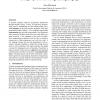Free Online Productivity Tools
i2Speak
i2Symbol
i2OCR
iTex2Img
iWeb2Print
iWeb2Shot
i2Type
iPdf2Split
iPdf2Merge
i2Bopomofo
i2Arabic
i2Style
i2Image
i2PDF
iLatex2Rtf
Sci2ools
OOPSLA
2007
Springer
2007
Springer
Living it up with a live programming language
A dynamic language improves programmer productivity through flexible typing, a focus on high-level programming, and by streamlining the edit-compile-debug cycle. Live languages go beyond dynamic languages with more programmer-centric features. A live language supports live programming that provides programmers with responsive and continuous feedback about how their edits affect program execution. A live language is also based on declarative programming constructs such as rules or data-flow connections so that programmers can write less code. A live language should also provide programmers with responsive semantic feedback to enable time-saving services such as code completion. This paper describes the design a textual live language known as SuperGlue. SuperGlue is based on reactive values known as signals that are supported with declarative data-flow connections and dynamic inheritance. Through signals and dynamic inheritance, SuperGlue supports live programming, declarative progra...
Related Content
| Added | 08 Jun 2010 |
| Updated | 08 Jun 2010 |
| Type | Conference |
| Year | 2007 |
| Where | OOPSLA |
| Authors | Sean McDirmid |
Comments (0)

